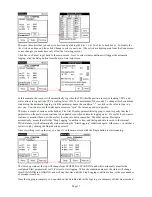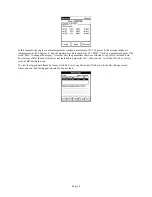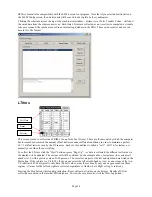
Page 6
Using the Stylus
For clicking buttons on a PDA, you use a stylus, which is just a plastic pointer. The stylus should be in its holder on
the back of the PDA. To use it, pull it out & tap the display where you want to “click”. If you don’t have the
sounds silenced, you should hear a little ticking noise when you click, and whatever icon you click on will cause its
associated program to run.
When you first start your PDA, you should see a screen full of program icons. To start a particular program, tap the
stylus on that program’s icon. To return to the main menu (set of icons), you need to press the Home button (see
Keyboard section below).
Other pointing devices can be used (like a fingernail if you lose the stylus), but may damage the touch screen.
Calibrating the Touch Screen
The screen on the PDA must be calibrated so the PDA knows where you’re “clicking”. Calibration has already been
done before your scanner was shipped, but to redo the calibration, click the Welcome icon. On the main screen of
icons (as shown above), there is a scroll bar on the right, since all of the icons won’t fit on one page. Drag the scroll
bar down or press the page-down button until the Welcome icon shows up. Then just follow the directions to
recalibrate the touch screen.
Setting the Contrast
To set the contrast, press the blue Shift button, then the letter Q on the keyboard. Use the on-screen slider to set the
contrast lighter or darker.
Using the Keyboard
Users of other Palm devices will notice the “graffiti” area is missing. To enter text with this PDA, you use the
ASCII keyboard. To enter text, just click on the letters with your finger just like you would use a standard
keyboard. On the right side of the keyboard, you will see the backspace key and arrow key, and the space bar is the
big wide one at the bottom of the keyboard. Next to the space bar is an up-arrow for capital letters. To use it, click
it once and the following letter will be capitalized. To the far right of the space bar is a key with a dot and line on it.
This is the “menu” button. Click it to drop-down the menu’s on certain programs. (Drop-down menu’s are not used
in the LS1M program.)
Notice that the keys have white letters but also some blue characters to the upper right. Those are the shift-mode
keys. You use them by pressing the blue shift button (lower left) and then press the key. So, for instance, if you
want to enter a number 5, press the blue shift key and then the J button. On the Menu button, notice the picture of a
little blue house. That’s the Home button. To get back to the Home screen (list of program icons), press the blue
shift button and then the Home key.
Using the Page-Up and Page-Down Buttons
Under the ASCII keyboard are some silver keys. The two buttons in the middle are the page-up and page-down
buttons. They are programmed to do certain things in the LS1M program, such as start/stop scanning on the Scan
screen. The other four silver buttons are shortcuts to various built-in programs on the PDA.
Installing Palm Desktop
Your PDA is shipped ready to use immediately, but if you would like to save data from the PDA to your computer,
you must install Palm Desktop and the LS1M Synchronizer. Palm Desktop software for Windows or Macintosh is
available as a free download from the Palm website:
http://www.palm.com/us/software/desktop/
The Windows version 4.1 is also available on the LS1M CD. To install it, navigate to the CD drive in the “Palm
Desktop Software” directory and run the install program “PDADesktop41ENG”. Follow the on-screen instructions
to install Palm Desktop on your computer.
When prompted, select “Complete Installation”






































